Learning to Cycle: From Training Wheels to Balance Bike
Abstract
:1. Introduction
2. Materials and Methods
2.1. Survey
- “About you”—Questions about the participant’s own experience and biographical data (e.g., place of residence, age, gender, physical activity habits, if they know to ride a bike, if not—why not, if yes—when did they learn, what types of bikes were used and in what sequence, where did they learn, who taught them, how often do they ride a bike, what do they use it for).
- “About your older child” (to be completed only if the participant has children)—These questions are the same as the questions in the first group but regarding the participant’s older child.
- “About your younger child” (to be completed only if the participant has more than one child)—These questions are the same as the questions in the first group but regarding the participant’s younger child.
2.2. Sample
2.3. Statistical Analysis
2.4. Sample Calculation
3. Results
3.1. Learning Age over Decades
3.2. Use of BB and BTW over Decades
3.3. Learning Paths
3.4. Order of Use of the Balance Bike
4. Discussion
4.1. Relation between BB’s Percentage of Use and the LA over Time
4.2. Learning Paths
4.3. Order of Use of Balance Bike
4.4. Strengths and Weaknesses
5. Conclusions
Author Contributions
Funding
Institutional Review Board Statement
Informed Consent Statement
Acknowledgments
Conflicts of Interest
References
- Herlihy, D.V. Bicycle: The History; Yale University Press: London, UK, 2004. [Google Scholar]
- Astrom, K.J.; Klein, R.E.; Lennartsson, A. Bicycle dynamics and control: Adapted bicycles for education and research. IEEE Control Syst. Mag. 2005, 25, 26–47. [Google Scholar] [CrossRef]
- Oosterhuis, H. Cycling, modernity and national culture. Soc. Hist. 2016, 41, 233–248. [Google Scholar] [CrossRef] [Green Version]
- Oja, P.; Titze, S.; Bauman, A.; de Geus, B.; Krenn, P.; Reger-Nash, B.; Kohlberger, T. Health benefits of cycling: A systematic review. Scand. J. Med. Sci. Sports 2011, 21, 496–509. [Google Scholar] [CrossRef] [PubMed]
- Ramírez-Vélez, R.; García-Hermoso, A.; Agostinis-Sobrinho, C.; Mota, J.; Santos, R.; Correa-Bautista, J.E.; Amaya-Tambo, D.C.; Villa-González, E. Cycling to School and Body Composition, Physical Fitness, and Metabolic Syndrome in Children and Adolescents. J. Pediatrics 2017, 188, 57–63. [Google Scholar] [CrossRef] [Green Version]
- Karabaic, L. Putting the Fun before the Wonk: Using Bike Fun to Diversify Bike Ridership; TREC Friday Seminar Series: Portland, OR, USA, 2016. [Google Scholar]
- Orsini, A.; O’Brien, C. Fun, Fast and Fit: Influences and Motivators for Teenagers Who Cycle to School. Child. Youth Environ. 2006, 16, 121–132. [Google Scholar]
- Smith, M.; Hosking, J.; Woodward, A.; Witten, K.; MacMillan, A.; Field, A.; Baas, P.; Mackie, H. Systematic literature review of built environment effects on physical activity and active transport—An update and new findings on health equity. Int. J. Behav. Nutr. Phys. Act. 2017, 14, 158. [Google Scholar] [CrossRef]
- Smith, M.; Ikeda, E.; Hawley, G.; Mavoa, S.; Hosking, J.; Egli, V.; Zhao, J.; Mackay, L.; Donnellan, N.; Amann, R.; et al. An integrated conceptual model of environmental needs for New Zealand children’s active travel to school. J. Transp. Health 2020, 16, 100814. [Google Scholar] [CrossRef]
- Phansikar, M.; Ashrafi, S.A.; Khan, N.A.; Massey, W.V.; Mullen, S.P. Active Commute in Relation to Cognition and Academic Achievement in Children and Adolescents: A Systematic Review and Future Recommendations. Int. J. Environ. Res. Public Health 2019, 16, 5103. [Google Scholar] [CrossRef] [Green Version]
- Zeuwts, L.; Ducheyne, F.; Vansteenkiste, P.; D’Hondt, E.; Cardon, G.; Lenoir, M. Associations between cycling skill, general motor competence and body mass index in 9-year-old children. Ergonomics 2015, 58, 160–171. [Google Scholar] [CrossRef]
- Bronfenbrenner, U. Development ecology through space and time: Future perspectives. In Examining Lives in Context: Perspectives on the Ecology of Human Development; American Psychological Association: Washington, DC, USA, 1995; pp. 559–647. [Google Scholar]
- Newell, K.M. Constraints on the development of coordination. In Motor Development in Children: Aspects of Coordination and Control, Wade, H.T.A.W.M.G., Ed.; Martinus Nijhoff: Dordrech, The Netherlands, 1986; pp. 341–360. [Google Scholar]
- Bronfenbrenner, U. The Ecology of Human Development: Experiments by Nature and Design; Harvard University Press: Cambridge, UK, 1979. [Google Scholar]
- Temple, V.A.; Purves, P.L.; Misovic, R.; Lewis, C.J.; DeBoer, C. Barriers and Facilitators for Generalizing Cycling Skills Learned at Camp to Home. Adapt. Phys. Act. Q. 2016, 33, 48–65. [Google Scholar] [CrossRef]
- Emond, C.R.; Handy, S.L. Factors associated with bicycling to high school: Insights from Davis, CA. J. Transp. Geogr. 2012, 20, 71–79. [Google Scholar] [CrossRef]
- Chandler, J.L.; Flynn, J.I.; Bassett Jr, D.R.; Aaron, K.; Walsh, J.; Manuel, K.; Fernandez, R.; Epperson, B.; Zavisca, E. A Community-Based After-School Program to Promote Bicycling Skills and Knowledge: Kids Can Bike! J. Park Recreat. Adm. 2015, 33, 90–99. [Google Scholar] [CrossRef]
- Florindo, A.A.; Barrozo, L.V.; Turrell, G.; Barbosa, J.P.d.A.S.; Cabral-Miranda, W.; Cesar, C.L.G.; Goldbaum, M. Cycling for Transportation in Sao Paulo City: Associations with Bike Paths, Train and Subway Stations. Int. J. Environ. Res. Public Health 2018, 15, 562. [Google Scholar] [CrossRef] [Green Version]
- Bronfenbrenner, U.; Morris, P.A. The ecology of developmental processes. In Handbook of Child Psychology: Theoretical Models of Human Development, 5th ed.; John Wiley & Sons Inc: Hoboken, NJ, USA, 1998; Volume 1, pp. 993–1028. [Google Scholar]
- Bronfenbrenner, U.; Morris, P.A. The Bioecological Model of Human Development. In Handbook of Child Psychology: Theoretical Models of Human Development, 6th ed.; John Wiley & Sons Inc: Hoboken, NJ, USA, 2006; Volume 1, pp. 793–828. [Google Scholar]
- Rodrigues, L.P.; Cordovil, R.; Luz, C.; Lopes, V.P. Model invariance of the Motor Competence Assessment (MCA) from early childhood to young adulthood. J. Sports Sci. 2021, 39, 2353–2360. [Google Scholar] [CrossRef]
- PCF. Ciclismo Para Todos. Available online: https://www.fpciclismo.pt/noticia-ciclismo-para-todos (accessed on 21 July 2020).
- PCF. O Ciclismo vai à Escola. Available online: https://www.fpciclismo.pt/pagina/o-ciclismo-vai-a-escola-2 (accessed on 21 July 2020).
- Becker, A.; Jenny, S.E. No Need for Training Wheels: Ideas for Including Balance Bikes in Elementary Physical Education. J. Phys. Educ. Recreat. Danc. 2017, 88, 14–21. [Google Scholar] [CrossRef]
- Shim, A.L.; Norman, S. Incorporating Pedal-less Bicycles into a Pre-K through Third-grade Curriculum to Improve Stability in Children. J. Phys. Educ. Recreat. Danc. 2015, 86, 50–51. [Google Scholar] [CrossRef]
- Mercê, C.; Branco, M.; Catela, D.; Lopes, F.; Rodrigues, L.P.; Cordovil, R. Learning to Cycle: Are Physical Activity and Birth Order Related to the Age of Learning How to Ride a Bicycle? Children 2021, 8, 487. [Google Scholar] [CrossRef]
- Chojnacki, M.R.; Holscher, H.D.; Balbinot, A.R.; Raine, L.B.; Biggan, J.R.; Walk, A.M.; Kramer, A.F.; Cohen, N.J.; Hillman, C.H.; Khan, N.A. Relations between mode of birth delivery and timing of developmental milestones and adiposity in preadolescence: A retrospective study. Early Hum. Dev. 2019, 129, 52–59. [Google Scholar] [CrossRef]
- Highman, C.; Hennessey, N.; Sherwood, M.; Leitão, S. Retrospective parent report of early vocal behaviours in children with suspected Childhood Apraxia of Speech (sCAS). Child Lang. Teach. Ther. 2008, 24, 285–306. [Google Scholar] [CrossRef]
- Field, A. Discovering Statistics Using IBM SPSS Statistics; SAGE Publications: London, UK, 2013. [Google Scholar]
- Andrews, E. Pedal Your Way through the Bicycle’s Bumpy History. Available online: https://www.history.com/news/bicycle-history-invention (accessed on 2 August 2020).
- Waddington, C.H. The Strategy of the Genes; George Unwin & Unwin: London, UK, 1957. [Google Scholar]
- Deforche, B.I.; Hills, A.P.; Worringham, C.J.; Davies, P.S.W.; Murphy, A.J.; Bouckaert, J.J.; De Bourdeaudhuij, I.M. Balance and postural skills in normal-weight and overweight prepubertal boys. Int. J. Pediatric Obes. 2009, 4, 175–182. [Google Scholar] [CrossRef]
- Kakebeeke, T.H.; Lanzi, S.; Zysset, A.E.; Arhab, A.; Messerli-Bürgy, N.; Stuelb, K.; Leeger-Aschmann, C.S.; Schmutz, E.A.; Meyer, A.H.; Kriemler, S.; et al. Association between Body Composition and Motor Performance in Preschool Children. Obes. Facts 2017, 10, 420–431. [Google Scholar] [CrossRef]
- McGraw, B.; McClenaghan, B.A.; Williams, H.G.; Dickerson, J.; Ward, D.S. Gait and postural stability in obese and nonobese prepubertal boys. Arch. Phys. Med. Rehabil. 2000, 81, 484–489. [Google Scholar] [CrossRef]
- Pau, M.; Kim, S.; Nussbaum, M.A. Does load carriage differentially alter postural sway in overweight vs. normal-weight schoolchildren? Gait Posture 2012, 35, 378–382. [Google Scholar] [CrossRef]
- Robinson, L.E. The relationship between perceived physical competence and fundamental motor skills in preschool children. Child Care Health Dev. 2011, 37, 589–596. [Google Scholar] [CrossRef]
- Stodden, D.F.; Goodway, J.D.; Langendorfer, S.J.; Roberton, M.A.; Rudisill, M.E.; Garcia, C.; Garcia, L.E. A Developmental Perspective on the Role of Motor Skill Competence in Physical Activity: An Emergent Relationship. Quest 2008, 60, 290–306. [Google Scholar] [CrossRef]
- Halverson Jr, C.E. Remembering Your Parents: Reflections on the Retrospective Method. J. Personal. 1988, 56, 435–443. [Google Scholar] [CrossRef]
- Sedgwick, P. What is recall bias? BMJ Br. Med. J. 2012, 344, e3519. [Google Scholar] [CrossRef]
- Pabayo, R.; Gauvin, L.; Barnett, T.A.; Nikiéma, B.; Séguin, L. Sustained Active Transportation is associated with a favorable body mass index trajectory across the early school years: Findings from the Quebec Longitudinal Study of Child Development birth cohort. Prev. Med. 2010, 50, S59–S64. [Google Scholar] [CrossRef]
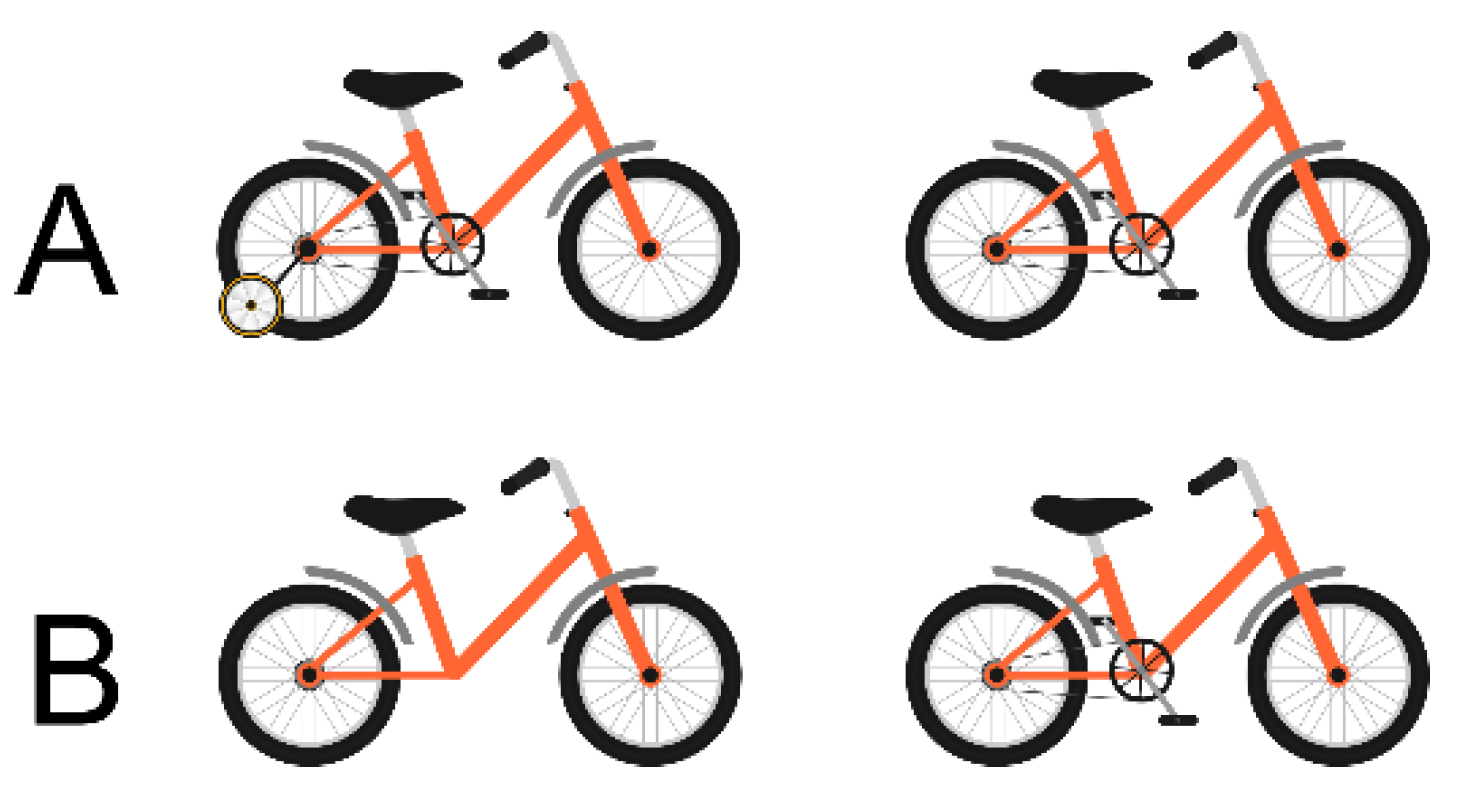
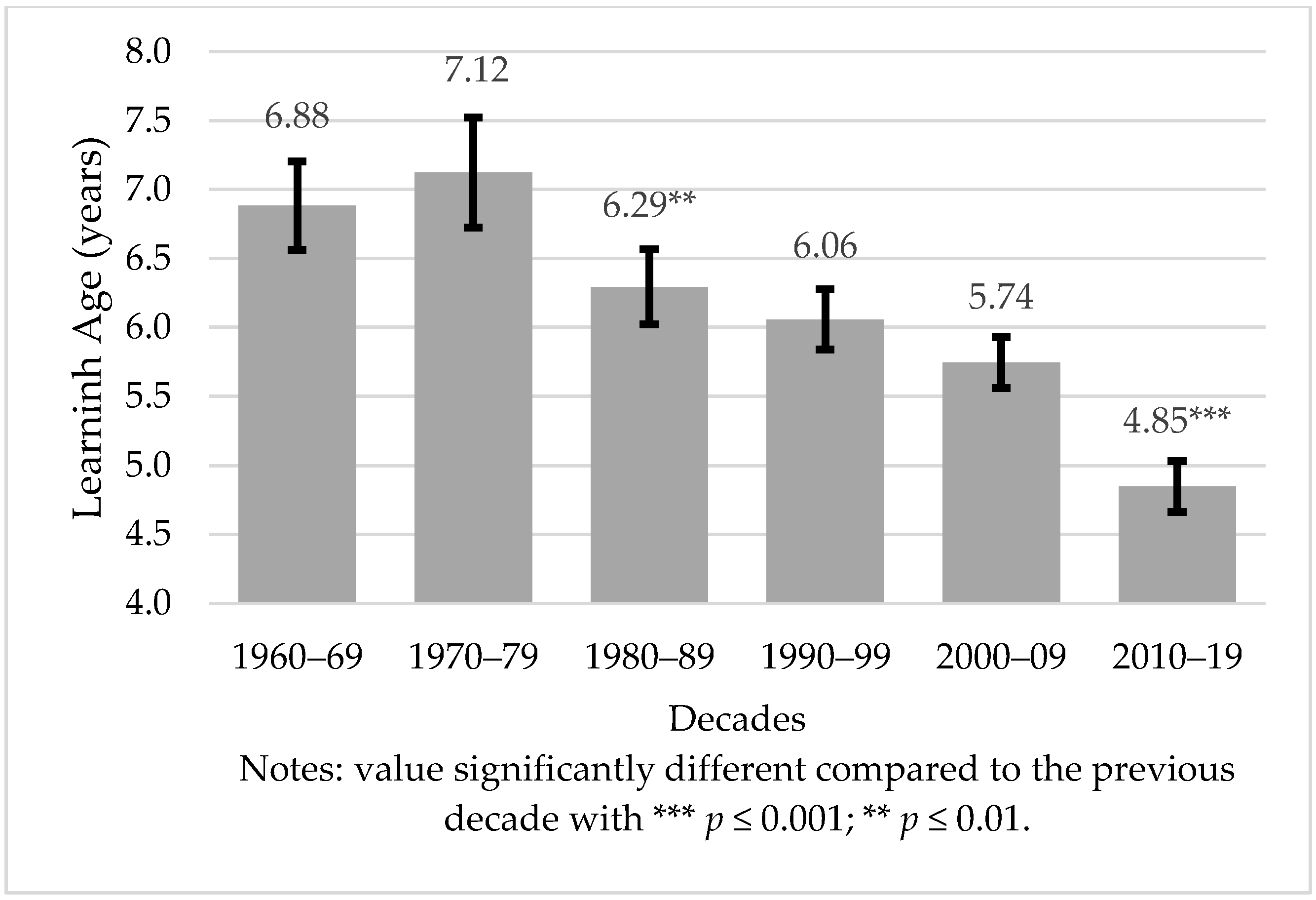
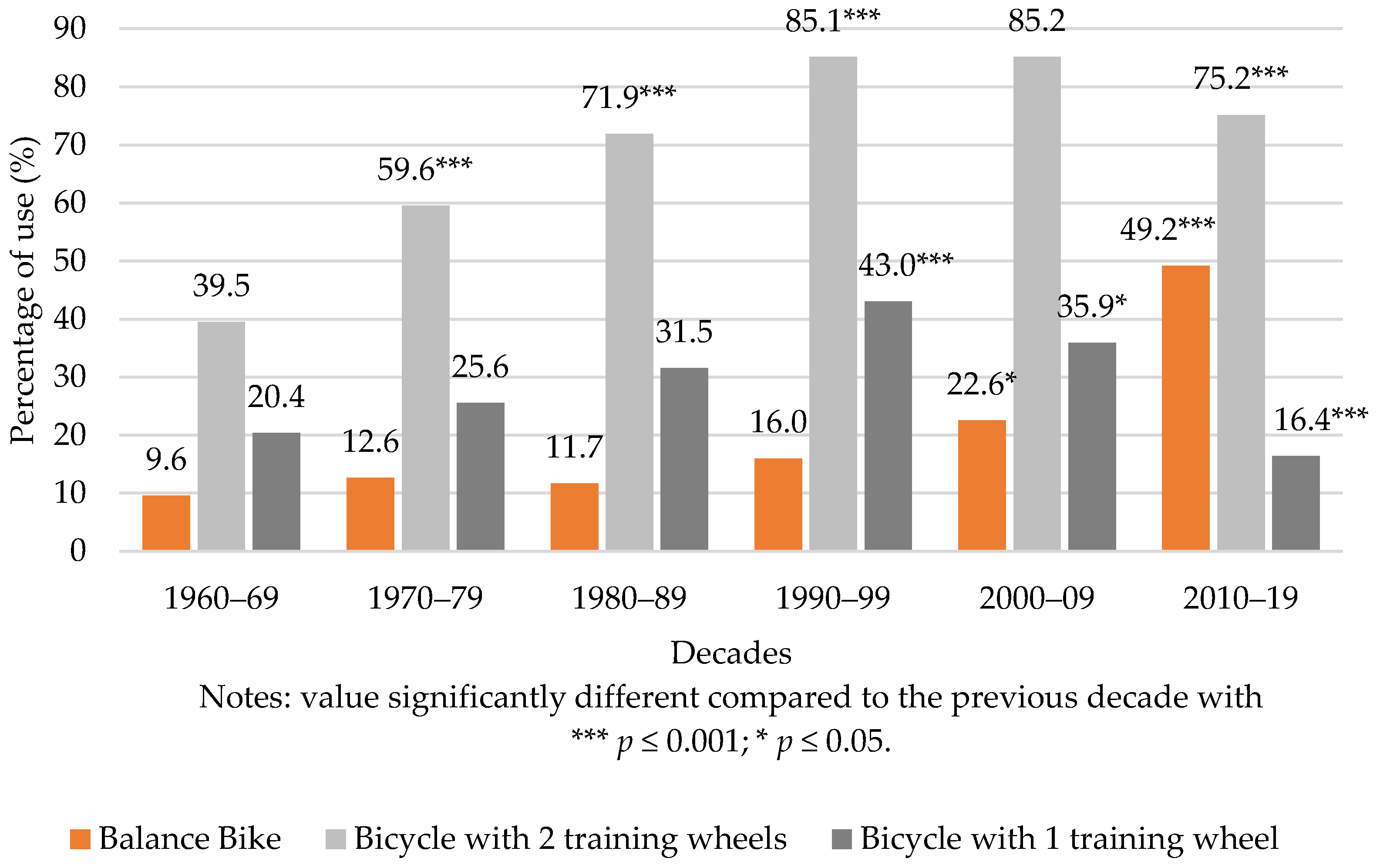
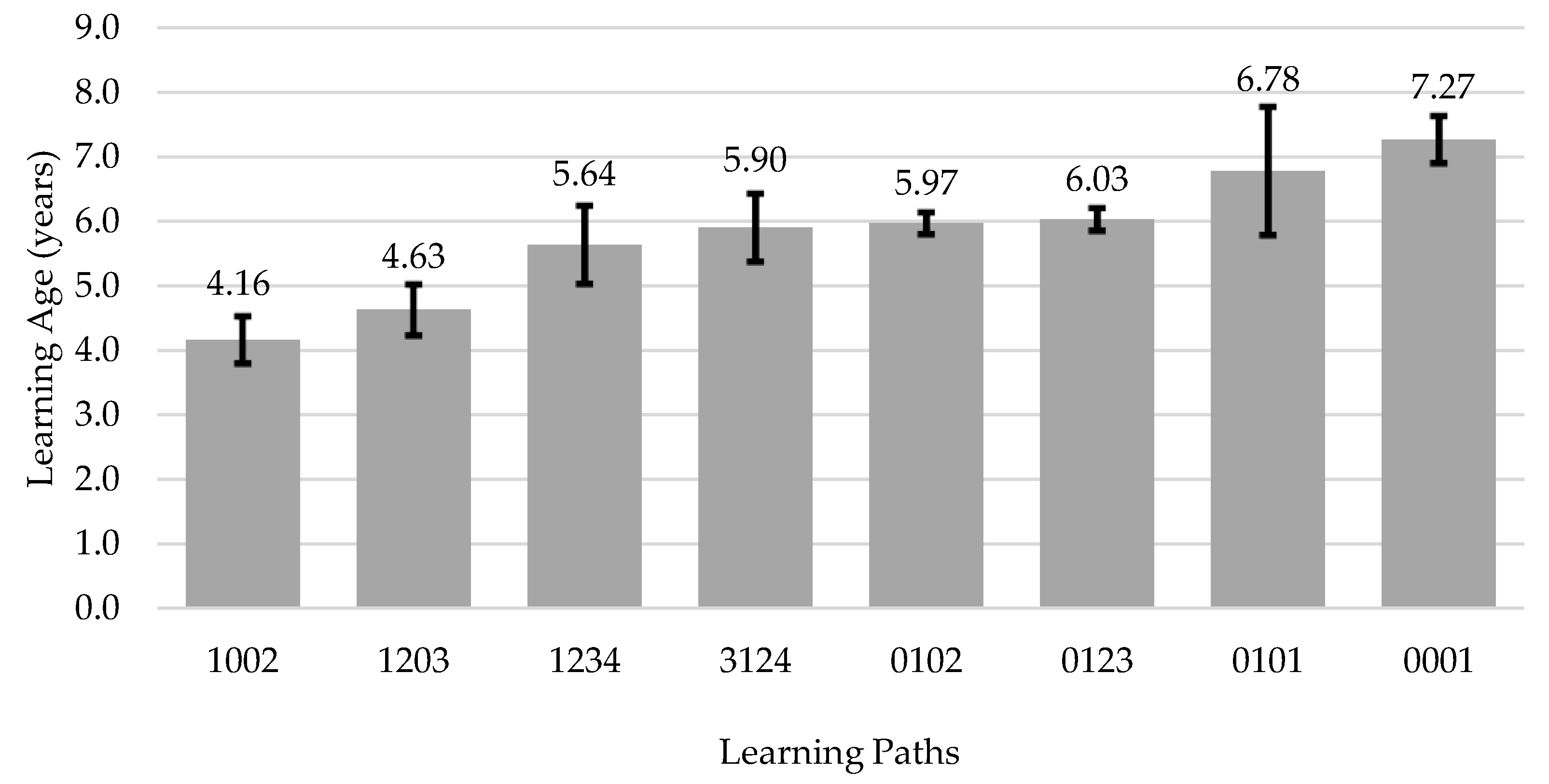
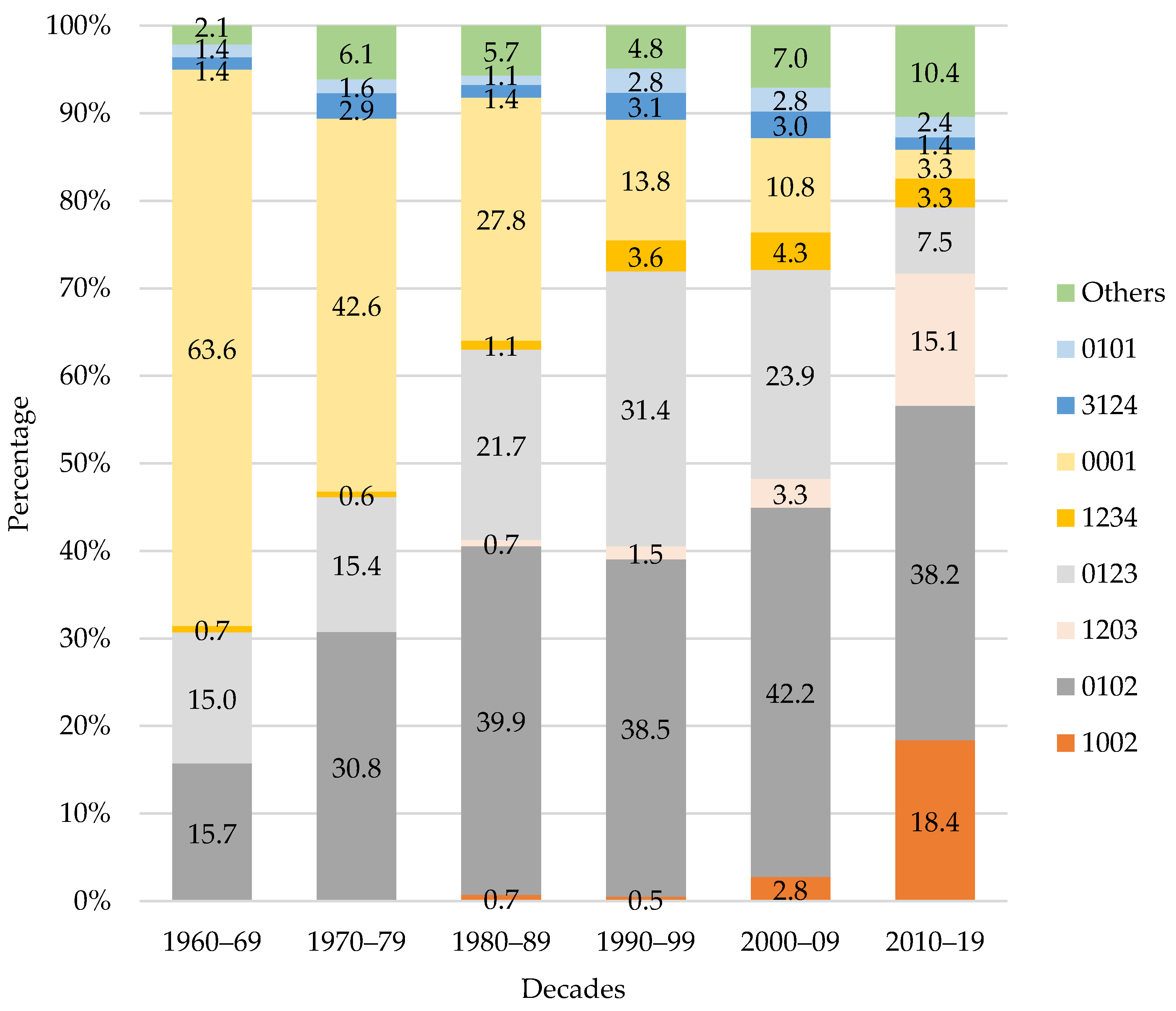
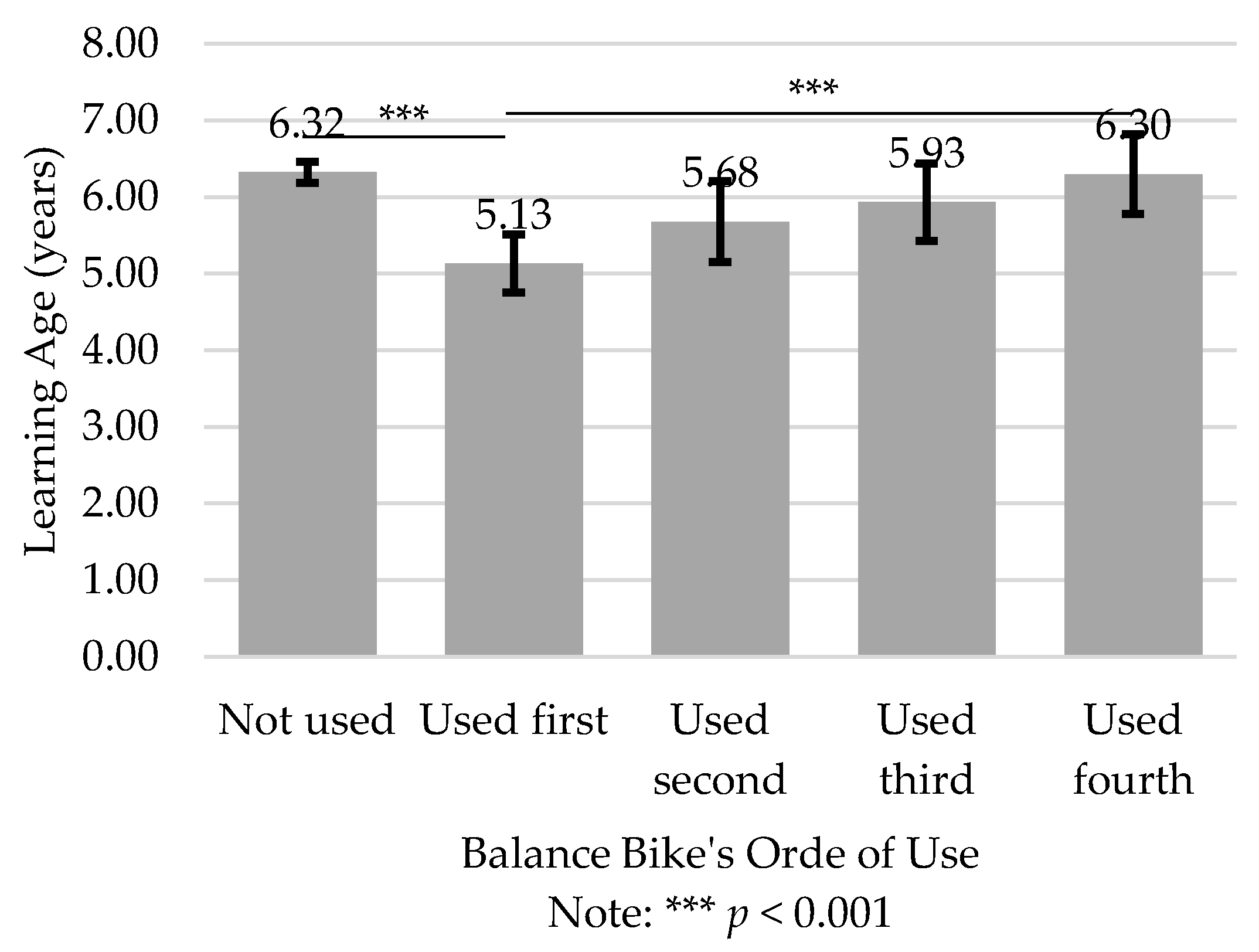
| Decades | Decimal Age (yrs) | Gender (n) | |||||
|---|---|---|---|---|---|---|---|
| Mean ± Standard Deviation | Minimum | Maximum | Male | Female | Don’t Want to Say | Total | |
| 1960–69 | 55.05 ± 2.70 | 50.05 | 60.18 | 31 | 129 | 0 | 160 |
| 1970–1979 | 44.53 ± 2.75 | 39.91 | 50.29 | 119 | 238 | 2 | 359 |
| 1980–1989 | 35.65 ± 2.92 | 29.98 | 40.23 | 92 | 227 | 0 | 319 |
| 1990–1999 | 23.79 ± 2.88 | 19.92 | 30.23 | 209 | 236 | 1 | 446 |
| 2000–09 | 15.92 ± 3.20 | 10.13 | 20.21 | 251 | 214 | 3 | 468 |
| 2010–19 | 7.34 ± 1.81 | 2.39 | 10.35 | 142 | 109 | 2 | 253 |
| Total | 27.97 ± 14.7 | 2.39 | 60.18 | 844 | 1153 | 8 | 2005 |
| Learning Path | Participants | Mean ± Standard Deviation | 95% Confidence Interval | Games Howell Significant Differences | |
|---|---|---|---|---|---|
| Lower | Upper | ||||
| 1002 | 54 | 4.16 ± 1.34 | 3.80 | 4.53 | All *** except 1203 |
| 1203 | 53 | 4.63 ± 1.44 | 4.23 | 5.03 | All *** except 1002 |
| 1234 | 44 | 5.64 ± 1.99 | 5.03 | 6.24 | 0001 ***, 0123 ***, 1002 ***, 1203 *** |
| 3124 | 42 | 5.90 ± 1.69 | 5.38 | 6.43 | 0001 ***, 1002 ***, 1203 *** |
| 0102 | 630 | 5.97 ± 2.16 | 5.80 | 6.14 | 0001 ***, 1002 ***, 1203 *** |
| 0123 | 364 | 6.03 ± 1.73 | 5.85 | 6.21 | 0001 ***, 1002 ***, 1203 ***, 1234 *** |
| 0101 | 37 | 6.78 ± 2.98 | 5.79 | 7.78 | 0001 ***, 1002 ***, 1203 *** |
| 0001 | 404 | 7.27 ± 3.74 | 6.90 | 7.63 | All *** |
Publisher’s Note: MDPI stays neutral with regard to jurisdictional claims in published maps and institutional affiliations. |
© 2022 by the authors. Licensee MDPI, Basel, Switzerland. This article is an open access article distributed under the terms and conditions of the Creative Commons Attribution (CC BY) license (https://creativecommons.org/licenses/by/4.0/).
Share and Cite
Mercê, C.; Branco, M.; Catela, D.; Lopes, F.; Cordovil, R. Learning to Cycle: From Training Wheels to Balance Bike. Int. J. Environ. Res. Public Health 2022, 19, 1814. https://doi.org/10.3390/ijerph19031814
Mercê C, Branco M, Catela D, Lopes F, Cordovil R. Learning to Cycle: From Training Wheels to Balance Bike. International Journal of Environmental Research and Public Health. 2022; 19(3):1814. https://doi.org/10.3390/ijerph19031814
Chicago/Turabian StyleMercê, Cristiana, Marco Branco, David Catela, Frederico Lopes, and Rita Cordovil. 2022. "Learning to Cycle: From Training Wheels to Balance Bike" International Journal of Environmental Research and Public Health 19, no. 3: 1814. https://doi.org/10.3390/ijerph19031814








